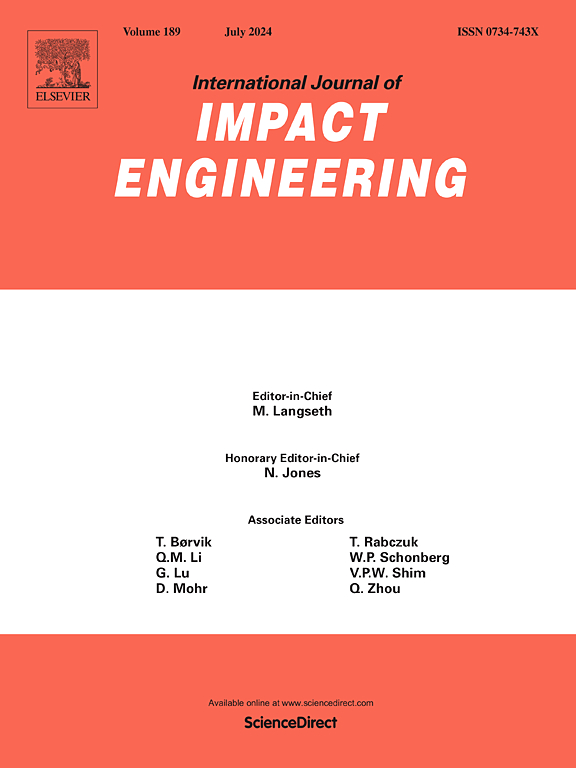The three-dimensional trajectory characteristics of the elliptical cross-section projectile into concrete target
IF 5.1
2区 工程技术
Q1 ENGINEERING, MECHANICAL
International Journal of Impact Engineering
Pub Date : 2025-06-04
DOI:10.1016/j.ijimpeng.2025.105414
引用次数: 0
Abstract
To gain a deeper understanding of the trajectory characteristics of oblique penetration of an elliptical cross-section projectile into concrete targets, a 3-D trajectory model for such a projectile was established. The wake-separation effect and cratering-effect were considered in the presented model. The 3-D trajectory model's accuracy and reliability were confirmed through oblique penetration tests. Lastly, the effects of various factors-including the ratio of the minor-axis and major-axis of the projectile cross-section (b), the asymmetry of the projectile cross-section (λ), the roll angle (ξ0), the attack angle (γ0), the sideslip angle (ψ0) and the oblique angle of the XOZ plane (α0)-on the trajectory of the elliptical section projectiles at oblique angles of the XOZ plane (β≠0°) were examined. Results indicate that, when the mass, the length, the length of projectile head and the cross-sectional area of the projectile and impact velocity are held constant, the trajectory stability of the major-axis side (ξ0=0°) of the symmetrical elliptical cross-section (b1=b2) projectile is superior to that of the circular cross-section projectile, while the trajectory stability of the minor-axis side (ξ0=90°) of the symmetrical elliptical cross-section projectile is inferior to that of the circular cross-section projectile at oblique angles of the XOZ plane. The range of γ0 between 0° and +5° is conducive to enhancing trajectory stability of the symmetrical elliptical section projectiles at oblique angles of the XOZ plane. In the event that ψ0 is not 0° or α0 is not 0° or ξ0 is neither 0° nor 90°, the symmetrical elliptical section projectile will be deflected in the YOZ, XOZ, and XOY planes at oblique angles of the XOZ plane. Especially, at range of the ξ0 between 50° and 60°, the max Y-direction displacement attains a peak value. And the terminal attitude angle on the YOZ plane demonstrates a quadratic correlation with the α0 and a linear correlation with the ψ0.
椭圆截面弹丸射入混凝土目标的三维弹道特性
为了更深入地了解椭圆截面弹丸斜侵彻混凝土目标的弹道特性,建立了椭圆截面弹丸斜侵彻混凝土目标的三维弹道模型。该模型考虑了尾迹分离效应和弹坑效应。通过斜侵彻试验,验证了三维弹道模型的准确性和可靠性。最后,考察了弹截面长、小轴比(b)、弹截面不对称度(λ)、滚转角(ξ0)、攻角(γ0)、侧滑角(ψ0)和XOZ面斜角(α0)等因素对椭圆截面弹在XOZ面斜角(β≠0°)处弹道的影响。结果表明,在质量、长度、弹头长度、弹体截面积和冲击速度一定的情况下,对称椭圆截面(b1=b2)弹丸的长轴侧(ξ0=0°)弹道稳定性优于圆形截面弹丸;而对称椭圆截面弹丸在XOZ平面斜角处的小轴侧(ξ0=90°)弹道稳定性不如圆形截面弹丸。γ - 0在0°~ +5°范围内有利于提高对称椭圆截面弹在XOZ面斜角处的弹道稳定性。当ψ0不为0°或α0不为0°或ξ0既不为0°也不为90°时,对称椭圆截面弹体将在YOZ、XOZ和XOY平面上以XOZ平面的斜角偏转。特别是在50°~ 60°范围内,最大y向位移达到峰值。yz平面的末姿态角与α0呈二次相关,与ψ0呈线性相关。
本文章由计算机程序翻译,如有差异,请以英文原文为准。
求助全文
约1分钟内获得全文
求助全文
来源期刊

International Journal of Impact Engineering
工程技术-工程:机械
CiteScore
8.70
自引率
13.70%
发文量
241
审稿时长
52 days
期刊介绍:
The International Journal of Impact Engineering, established in 1983 publishes original research findings related to the response of structures, components and materials subjected to impact, blast and high-rate loading. Areas relevant to the journal encompass the following general topics and those associated with them:
-Behaviour and failure of structures and materials under impact and blast loading
-Systems for protection and absorption of impact and blast loading
-Terminal ballistics
-Dynamic behaviour and failure of materials including plasticity and fracture
-Stress waves
-Structural crashworthiness
-High-rate mechanical and forming processes
-Impact, blast and high-rate loading/measurement techniques and their applications
 求助内容:
求助内容: 应助结果提醒方式:
应助结果提醒方式:


